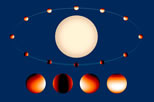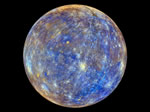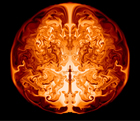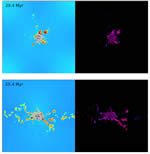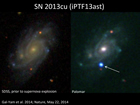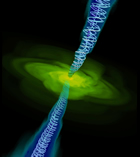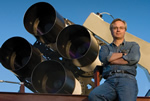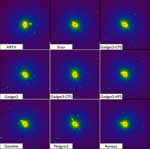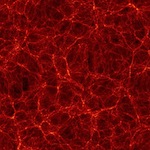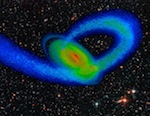Word doc
PDF (formatted and ready to go as a single newsletter page)
Measuring Olbers’s Paradox
Why is the sky dark at night? That question puzzled centuries of astronomers, including Thomas Digges, Johannes Kepler, and Edmond Halley. After all, if the universe were infinite in all directions, it would be filled with an infinite number of stars, whose collective glow would make the night sky bright. So did a dark sky at night imply that the universe was not infinite? The conundrum was given the name of Olbers’s paradox, after the German astronomer Wilhelm Olbers who discussed it in the 1820s.
Well, it turns out that those historical astronomers, working just from first principles, were onto something truly profound—but for reasons they could not anticipate.
Even from deep space far away from the lights of Earth and the stars of the Milky Way, the sky of intergalactic space is not absolutely black. It does faintly glow with photons from galaxies, both bright galaxies and those too distant to resolve with current instruments. That ever-so-faint glow is called the extragalactic background light (EBL).
Extragalactic background light
Streaming through deep space today in some form is almost all the light that all galaxies have radiated throughout the history of the Universe. Some of these photons are extraordinarily ancient, emitted billions of years ago and red-shifted (expanded in wavelength) with the expansion of the universe. Other photons are comparatively recent from local galaxies nearby. Together, these photons crisscrossing space suffuse the Universe with a faint background glow in the ultraviolet, visible, and infrared regions of the spectrum, rendering the deep night-black void between galaxies not totally dark.
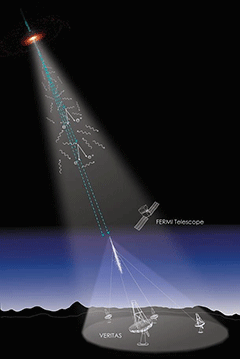
Energetic gamma rays (dashed lines) from a distant blazar strike photons of extragalactic background light (wavy lines) in intergalactic space, annihilating both gamma ray and photon. Different energies of EBL photons waylay different energies of gamma rays, so comparing the attenuation of gamma rays at different energies from different spacecraft and ground-based instruments indirectly measures the spectrum of EBL photons. Credit: Nina McCurdy and Joel R. Primack/UC-HiPACC; Blazar: Frame from a conceptual animation of 3C 120 created by Wolfgang Steffen/UNAM
Measuring the EBL directly is difficult, however, because our solar system and our Milky Way galaxy are themselves awash in light. Only in the past year or so have astronomers succeeded in obtaining actual measurements of the elusive EBL using a clever indirect work-around: observations of gamma rays from blazars—galaxies with supermassive black holes producing jets of gamma rays that happen to be pointed at Earth. The latest results were published in The Astrophysical Journal in May 2013 by Alberto Domínguez of the University of California, Riverside, and coauthors.
These pioneering measurements are possible because gamma rays from distant sources collide with lower-energy visible and infrared EBL photons, annihilating both; those collisions with EBL photons thus remove some of the gamma rays. Different energies of the highest-energy gamma rays are waylaid by different energies of EBL photons. Thus, measuring how much gamma rays of different energies are attenuated from blazars at different distances from Earth indirectly gives a measurement of how many EBL photons of different wavelengths exist along the line of sight from blazar to Earth over those different distances. The new measurements required combining data on X-ray and gamma-ray blazar emissions from space observatories with observations of the highest-energy gamma rays detected by Atmospheric Cherenkov Telescopes on the ground.
What the measurements reveal
The result? The EBL both nearby and from earlier (more distant) epochs is consistent with expectations from the number of galaxies observed, with little room for additional light from exotic hypothetical sources. This important measurement constrains when and how the universe was reionized during the first billion years.
The EBL measurements also show that the galaxies that were shining at “cosmic high noon”—the period from about eight to twelve billion years ago when stars were forming most rapidly—were unlike most nearby galaxies. Nearby galaxies emit most of their light near visible wavelengths. But at cosmic high noon, exploding stars produced dust (made of heavier elements such as carbon, oxygen, and iron) that enveloped star-forming regions and absorbed much of the ultraviolet and visible light, which was reradiated at much longer infrared. As this dust built up in galaxies over cosmic time, it allowed later generations of stars to form along with rocky planets, including Earth.
Future measurements of the EBL using gamma rays from farther away can help reveal the nature of the first stars and galaxies.
–Trudy E. Bell, M.A.
Further reading: A press release summarizing this work is at http://hipacc.ucsc.edu/PressRelease/CGRH.html. The paper “Detection of the Cosmic γ-Ray Horizon from Multiwavelength Observations of Blazars,” by Alberto Domínguez and six coauthors in The Astrophysical Journal is at http://arxiv.org/pdf/1305.2162v1.pdf. A definitive book on the history of Olbers’s paradox is Darkness at Night: A Riddle of the Universe by Edward Harrison (Harvard University Press, 1989).
The University of California High-Performance AstroComputing Center (UC-HIPACC), based at the University of California, Santa Cruz, is a consortium of nine University of California campuses and three Department of Energy laboratories (Lawrence Berkeley Laboratory, Lawrence Livermore Laboratory, and Los Alamos National Laboratory). UC-HiPACC fosters collaborations among researchers at the various sites by offering travel and other grants, co-sponsoring conferences, and drawing attention to the world-class resources for computational astronomy within the University of California system. More information appears at http://hipacc.ucsc.edu .
